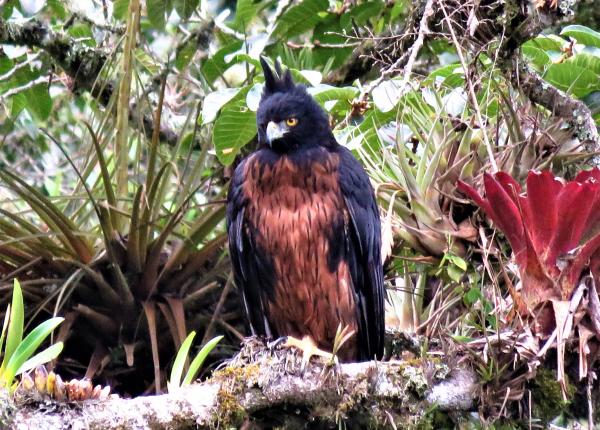Did you know?
- Despite its large size, the Black-and-chestnut Eagle can be difficult to observe and study because it occurs in such remote and rugged areas.
- This species is also known as Isidor's eagle.
- It is the largest member of the genus Spizaetus.
- The Black-and-chestnut Eagle is one of the least studied of the Neotropical Raptors
How The Peregrine Fund is Helping
Though The Peregrine Fund doesn't work directly with Black-and-chestnut Eagle, we do support students who are studying this beautiful bird of prey. Additionally, our efforts in scientific research, habitat conservation, education, and community development help conserve raptors around the world. We also supply literature to researchers from our avian research library, which helps scientists the world over gather and share important information on raptor conservation.
Where They Live
The Black-and-chestnut Eagle is found throughout the South American continent from Colombia south to Argentina. It lives mostly in dense, montane forest along mountain slopes, as well as in undisturbed wet cloud forest.
It is usually found from between 1,500 and 2,800 m, but has been recorded from sea level to 3,500 m.
What They Do
The Black-and-chestnut Eagle is a stunning bird of prey. As its name implies its colors are primarily black and chestnut. Its breast and lower belly is a deep rufous color. Its head, back, and wings are a deep and shiny black. It also has a relatively short black crest and piercing yellow eyes.
This lovely bird can often be seen soaring over its forest habitat. It tends to be more active early in the morning. It will sometimes sit on an exposed perch, but more often than not it prefers to remain perched inside the forest.
Like many raptors, the Black-and-chestnut Eagle is a top predator – it hunts other animals for food but no animals hunt it on a regular basis. For most top predators, their only threat is humans. Top predators, such as this eagle, play an important role in nature by helping to control populations of prey animals and maintain a balance in the ecosystems where they live.
Why They Need our Help
The Black-and-chestnut Eagle needs undisturbed primary forest in which to hunt, nest, and survive. Sadly, its forest habitat is being destroyed, mainly due to its conversion into agricultural fields. Other threats including mining and logging.
Another major threat is human persecution. The Black-and-chestnut Eagle does hunt chickens and this makes it a target. As more of its forested habitat is developed, this could increase as this species comes more and more in contact with humans and their associated domestic fowl.
This species is categorized as Endangered meaning its populations are low enough that scientists worry about its future if no conservation efforts are made on its behalf.
What They Eat
This stunning raptor feeds on large arboreal birds, including Sickle-winged Guans and mid-sized mammals such as squirrels, coatimundis, porcupines and monkeys. When hunting, it often waits on a perch inside the forest. When it spots potential prey, it will ambush it with a quick flight, grabbing it with its sharp talons.
Nests, Eggs, and Young
The Black-and-chestnut Eagle builds huge nest structures composed of sticks and twigs. It makes its nest high in a tall tree - usually one emerging from the top of the forest canopy.
When the time comes, the female will lay a single egg. She will do the majority of the incubating and caring for the young once it hatches. During this time, the male is responsible for feeding himself and his entire family.
A newly hatched Black-and-chestnut Eagle nestling is so small that it fits perfectly into the palm of a person’s hand. In only a few months, though, it will reach adult size! Because the nestling grows so quickly, it needs to eat a lot and it needs to eat often. When the nestling is very young, the mother will tear off small pieces of meat for and delicately feed it with her bill. Later, the young eagle will be able to tear off and eat the meat on its own
Resources:
Aráoz, R., Grande, J.M., López, C., Cereghetti, J. and Vargas, F.H., 2017. The first Black-and-chestnut Eagle (Spizaetus isidori) nest discovered in Argentina reveals potential human–predator conflicts. Journal of Raptor Research, 51(1), pp.79-82.
BirdLife International 2016. Spizaetus isidori. The IUCN Red List of Threatened Species 2016: e.T22696207A93549661. https://dx.doi.org/10.2305/IUCN.UK.2016-3.RLTS.T22696207A93549661.en. Downloaded on 31 March 2020.
Global Raptor Information Network. 2020. Species account: Black-and-chestnut Eagle Spizaetus isidori. Downloaded from http://www.globalraptors.org on 30 Mar. 2020
Larrea, M., Gallego, D., Aráoz, R. and Grande, J.M., First results on parental care of the black-and-chestnut eagle (Spizaetus isidori) in the Yungas area of Jujuy.
Valdez, U. and Osborn, S., 2004. Observations on the ecology of the Black-and-chestnut Eagle (Oroaetus isidori) in a montane forest of southeastern Peru. Ornitología Neotropical, 15, pp.31-40.
Zuluaga, S. and Echeverry-Galvis, M.Á., 2016. Domestic fowl in the diet of the black-and-chestnut eagle (Spizaetus isidori) in the eastern Andes of Colombia: a potential conflict with humans. Ornitología Neotropical, 27, pp.113-120.










